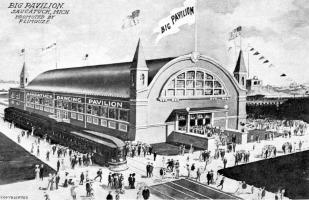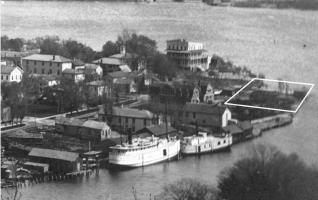Dec 14, 2005 |
|
Dec 14, 2005 |
|
 Limouze created a promotional rendering of what was to come - not bad! |
 In this 1907 shot from Mt. Baldhead, the future site is outlined in white. |
|
In an area rich with gems of the past, the Big Pavilion story is the crown jewel. The Pavilion’s mere existence evokes superlatives. Impossible, marvelous, largest, brightest, unforgettable, famous and finally tragic are just a few. The Pavilion defined the Saugatuck area from 1909 to 1960 and made the resort business major league. In an era of small town summer pavilions the “The Brightest Spot on the Great Lakes” was king. The historical tale of the Pavilion is best understood by recounting changes that occurred in the area. By 1905, lumbering, tanning, ship building and fruit growing had peaked and were going-going-almost gone. But the beautiful and glorious Saugatuck location on river and lake --a quick boat ride from burgeoning Chicago—were newly discovered and appreciated. Saugatuck sported a new municipal water system and electricity was just around the corner. The interurban brought visitors from the north and east. The new Leiendecker Inn and the Butler Hotel graced the waterfront. Opportunity was a knocking. By the fall of 1905 Frederick Limouze--a man with big ideas—had found what he was looking for and began to knock. The real story is thin of hard facts but logical clues abound. The Commercial Record broke the story with the headline: “SAUGATUCK HAS SECURED BIG PRIZE”. The story related, “Mr. Limouze of the North Shore Company and Mr. H. H. Engle of South Haven purchased Monday the dock property owned by Roger E. Reed and Alfred S. Taylor. The property is one of the choicest locations in Saugatuck and is in the heart of the village. The property consists of one square block having a frontage of over 300 feet and a depth of over 20 feet of water. It is now the landing of the John A. Aliber. The property is now occupied by Mr. Reed as a coal yard and also the waiting room of the terminal electric road. A new pavilion will be erected on the site by the first day of May, next, and will be put on a much grander scale than the one now built in South Haven”. Mr. Limouze and others (probably including H. H. Engle) had just completed the North Shore Pavilion dance hall which was built in less than a month on the lakeshore in South Haven. The involvement of Limouze and Engle in its operation is unknown. It burned in 1913. The Saugatuck coal yard property consisted of four city lots in the area between The Butler Hotel (now the Butler restaurant) and Leindeckers (now the Coral Gables). Per the 1907 tax assessment roll this property was owned by H. H. Engle, so he probably supplied capital to purchase the land. Frederick Limouze appears to have been the sparkplug and the promoter. Census records show that he was born in 1856 in New Jersey – his father was a barber and a French immigrant. In the 1900 census for Chicago Mr. Limouze is single, engaged in real estate and residing in a boarding house. By 1910 he had come up in the world – the Federal census of Chicago for that year has him married to Emily, age 35, and owning a home without a mortgage. His occupation is listed as promoter of pavilions.
Some time passed before Limouze,
Engle and others formed the Saugatuck Amusement Company. Finally in 1909
they were ready for their first move. In March of that year the Commercial
Record reported; “In an interview with Mr. Frederick Limouze of California,
he tells of the immense pavilion he and his associates are about to commence
on the dock property just south of Leiendecker’s Inn”. Thanks goes to Kit Lane and her book "Saugatuck's Big Pavilion: The Brightest Spot on the Great Lakes". It is available from the Historical Society and at most local book stores. |